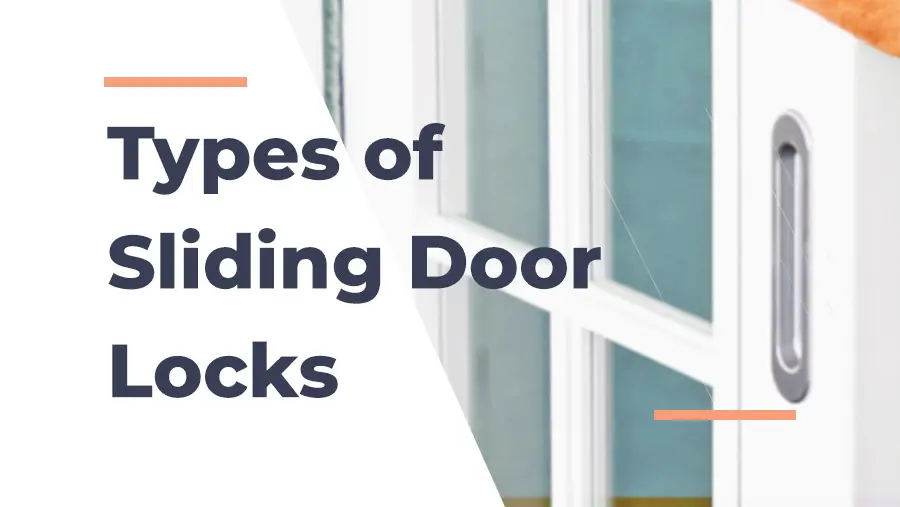As a security manager, I’m fully aware of the fact that sliding glass doors are often the least secure entry points of a house.
The main reason for this is that the built-in locking mechanism that comes with most sliding doors is pretty unreliable and easy to jimmy open, to put it mildly.
Another problem is that most homeowners are not really aware of all the options available when it comes to locks.
My goal with this article is to give you a helpful and thorough overview of all the main types of sliding glass door locks that are currently available on the market.
I also share my own experiences and include some useful tips so that you can find and choose the type of lock that best suits your needs.
First, here’s a quick overview of the typical installation locations:
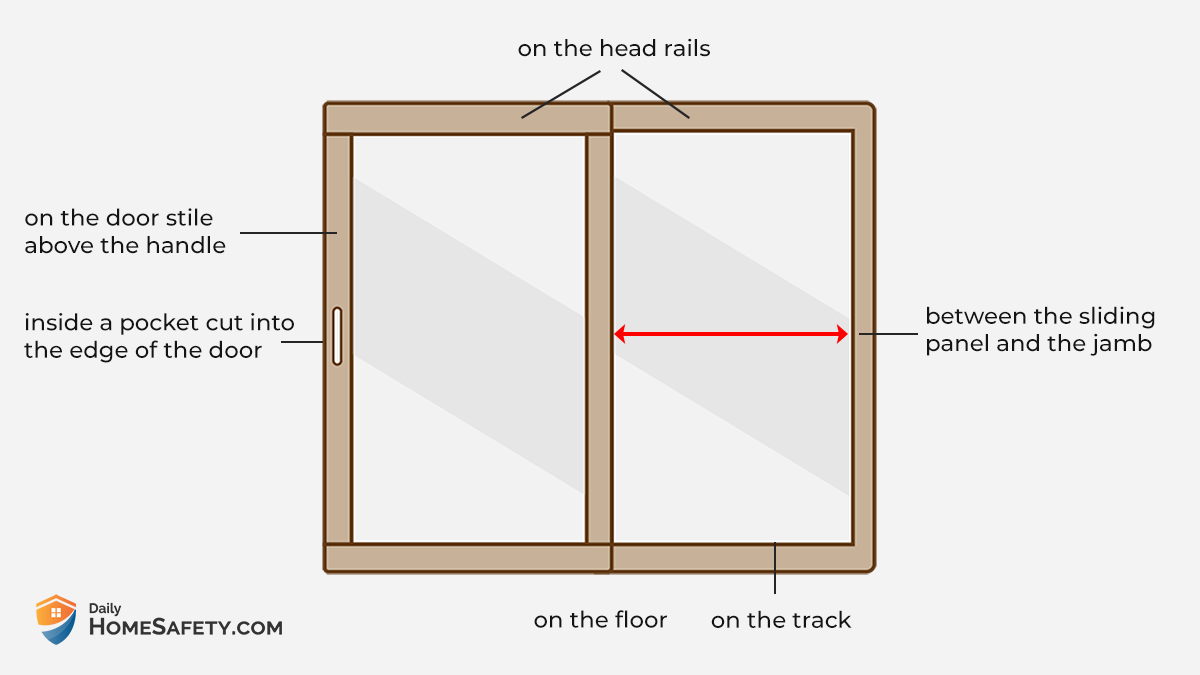
And now, let’s see the different lock types, one by one.
1. Mortise Sliding Door Locks
This is the most common type of sliding door lock. If you have a sliding glass door, chances are good that it came with either a pre-built mortise lock or a simple latch.
The whole body of a mortise lock sits inside a pocket (aka mortise) that is cut into the width of the door. Therefore this part of the lock is basically invisible.
Speaking of the structure, a mortise sliding door lock usually consists of 3 main parts:
- handles (interior and exterior)
- thumb latch
- mortise lock body
This is what they look like:
The handles are usually made of steel, wood, or plastic and in most cases can be independently replaced without having to touch the mortise lock itself.
How does the lock work?
It’s simple: by pulling up or turning (depending on the model you have) the thumb latch, the position of the hook changes and the door opens. If you want to close the door, all you need to do is pull (or turn) the thumb latch in the opposite direction.
Most mortise sliding glass door locks are non-keyed, hence they won’t allow you to lock or unlock the door from the outside. Some models, however, can be converted to work with a key.
Keep in mind that not all types of sliding doors will accept a mortise lock. If you’re in doubt whether yours is compatible with it, I recommend you reach out for expert help.
Pro Tip
If your sliding door came with a mortise lock, I highly recommend that you install a secondary lock, such as a double bolt lock, to prevent intruders from taking your door off the track.
2. Keyed Sliding Door Locks
If you want to lock your sliding patio door from the outside, you’ll most probably need a keyed lock.
Some handles allow you to add a key cylinder, however, if yours don’t, you’ll also need to get a new door handle. In this case, it’s best practice to buy a key lock set that includes handles too.
A key lock will do the same job from the outside as a thumb latch does from the inside: it turns the hook into an open position.
In my experience, keyed sliding door locks (especially hook locks) are not the best choice if security is a concern.
A key lock is usually not too hard to bypass, and if that’s the only thing that secures your patio door (and home), an experienced burglar can get inside in a matter of seconds.
Since most of the models available on the market are flush mount locks, installation is pretty straightforward. Before choosing, however, keep in mind to make sure it’ll fit your door and also check if the handles can be used on both right and left-handed patio doors.
In conclusion, a keyed lock can be pretty convenient as it allows you to lock the sliding door from the outside but it comes at a cost. If you leave the house through the patio door, you can’t activate any secondary lock and the keyed lock provides little protection against intruders in itself.
3. Two-Bolt Sliding Glass Door Locks
Two-bolt locks fall into the category of secondary locks. In the vast majority of cases, these types of sliding door locks don’t come with the door. Instead, they can be easily installed on existing patio doors.
What are the main benefits of a double-bolt lock?
- it prevents the door from being lifted out of its track
- it’s very simple to use
- works on most sliding doors
- quick and simple installation
A double bolt lock (aka sliding door deadbolt lock) works independently of the existing mortise or any other type of lock. In most cases, the lock itself should be installed on the door stile above the handle, while the fixed, non-moving part has to be mounted on the door jamb.
There are many models you can choose from, however, one of my favorite two-bolt locks is Armor Latch. I’ve tried many similar products over the years and I’ve come to the conclusion that Armor Latch has the best overall performance.
Here’s a short video on how it works:

Besides being pretty secure, this sliding door lock is quite convenient to use. Also, it’s made by a trusted manufacturer, Armor Concepts which has been offering highly popular and effective home security items since the early 2000s.
I highly recommend you add a secondary two-bolt lock to your door as it will counterbalance many of the weaknesses of the standard locking mechanism and greatly improve security as well.
Make sure you also check out this guide if you need to lock a sliding door without a lock.
4. Loop Locks
Like the previous type of patio door lock, these are also considered secondary locks, therefore can be quickly and easily installed on an existing door.
The main idea behind loop locks is that they secure the sliding door to the jamb.
They’re usually made of hardened steel which makes them pretty durable.
A sliding door loop lock has 3 main parts:
- locking bar
- mounting plate
- keeper
The mounting plate has to be installed on the door jamb, while the keeper should be mounted on the sliding glass door.
When the device is in a locked position securing the patio door, one end of the U-shaped locking bar sits in the keeper while the other end is attached to the mounting plate. To open the door, all you need to do is pull the locking bar up.
Using a loop lock is an affordable way to add another layer of security to your sliding glass door. Although it’s not as secure as a double bolt lock, it’s much better than a standard hook lock alone.
Click here to see an example.
5. Sliding Door Track Locks
If you need a really quick solution and want a hassle-free installation without screwing and drilling, using track locks (slider locks) is one of your best bets.
Track locks are extremely simple security devices: they’re tightly fixed on the rail of the sliding door or window (yes, you can use them on sliding windows as well) and act as a barrier to prevent any movement.
The real benefit of a track lock is portability and tool-less installation. Also, unlike many other types of sliding patio door locks, it allows locking the door in a ventilating position.
To secure your sliding glass door, you just have to mount the lock onto the track using the thumbscrew. A simple, quick, and inexpensive solution.
Keep in mind that track locks are not as secure as most other auxiliary locks, however, you can use multiple of them on both the upper and lower track. This way they’ll be more resistant to external forces.
You’ll find some useful tips about how you can further improve sliding door security in this article.
6. Surface-Mounted Hook Bolt
There are several models on the market that fall into this category. These locks can be mounted above or below the existing lock and work with most standard sliding doors.
Here’s an example of a surface-mounted hook bolt:
This auxiliary lock will allow you to lock the door both from the inside and outside. The exterior panel has a keypad and after entering the correct password, the device unlocks the door.
This feature is especially useful if you need to lock and unlock your sliding glass door from the outside and you prefer a keyless solution.
To be honest, this is the single unique benefit that I can mention. Keep in mind that it’s not a smart lock (although it may look like one), therefore it’s not compatible with any wifi or Bluetooth locking systems.
In my opinion, if you don’t really need a keyless solution, you can just opt for a standard keyed patio door lock instead. That’s less prone to failure.
7. Sliding Door Barricades

Sliding door barricades provide pretty reliable protection as they use the strength of the floor to prevent the sliding panel from moving.
My favorite sliding door barricade is the one that is manufactured by Nightlock. This is the product I had by far the best experience with. It’s officially called a sliding door security lock, but it’s basically a barricade.
How does it work?
First, you have to anchor the base plate to the floor using the included screws. And yes, it requires drilling, so you need to have the necessary equipment (power drill, screwdriver) at hand. The installation process is not complicated at all and it takes about 20-30 minutes.
Once you’re done with the installation, all you have to do is slide the lock rail toward the door to secure the sliding panel.
It’s important to note that the device will work only on those doors that have the sliding panel on the inside track. Also, unlike double-bolt locks, it won’t protect the door from being lifted out of the track.
If you don’t mind bending, a door barricade is hands down one of the most durable and robust solutions out there to block your sliding patio door.
8. Automatic Sliding Door Locks and Smart Locks
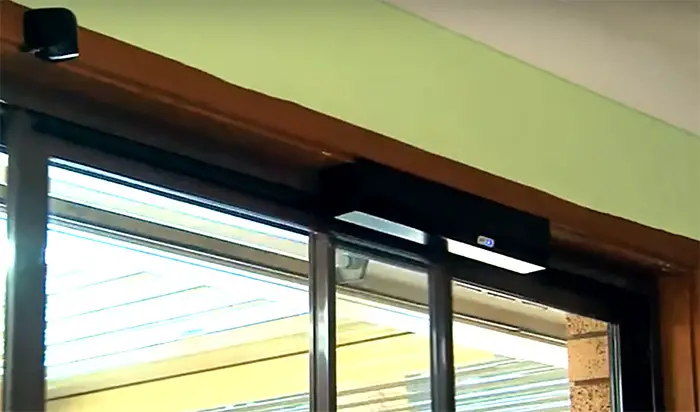
To tell the truth, there’s not a large selection of smart locks for sliding doors. In fact, there are only a handful of companies that sell these kinds of locks.
One of them is Autoslide that’s specialized in sliding door and window automation. It has two core products. One basic automatic sliding door kit and the MultiDrive System that features smart home integration as well.
These systems are perfect if you need your sliding glass patio door to open automatically for your pet or accessibility reasons, for instance.
The MultiDrive System also allows you to remotely lock and unlock the door, so you can control the state through a smartphone app.
These locks are by far the most expensive ones on the list, however, it’s also true that no other sliding door lock type features automation and remote accessibility. So if that’s what you need, this might be a good choice for you.
Keep in mind that in most cases installation is not a DIY project, and you’re better off leaving it to an expert.
9. Electromagnetic Sliding Door Lock
If you don’t have the budget for a smart lock but need an electrically powered lock for some reason, you might want to have a closer look at electromagnetic locks.
These are not made exclusively for sliding doors, so chances are good that you’ll have to be a little creative when installing them as they might not fit perfectly to your existing door.
I recommend that you use a surface-mounted shear magnetic lock that has a holding force between 1,000 and 3,000 lbs (you can choose according to the level of security you need).
Here’s an example:
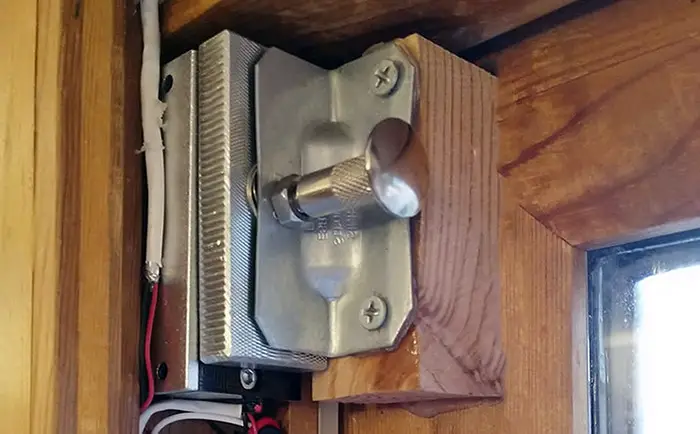
One part of the lock goes onto the door frame and the other should be mounted on the sliding door panel.
The obvious disadvantage of this kind of lock is that it won’t work if the power is cut (it stays in an unlocked position).
Overall, I can’t really recommend magnetic locks since they’re cumbersome to set up and won’t operate without electricity.
10. Security Bar
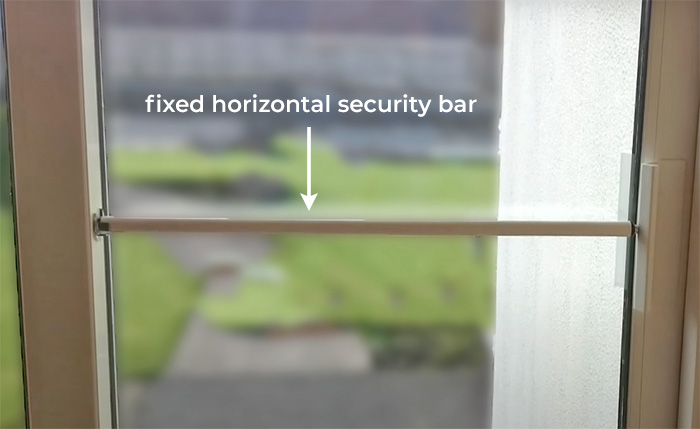
Security bars are pretty versatile, as you can use them to lock many different kinds of doors and windows as well.
There are two main types of security bars, fixed and portable models. Both are considered secondary locks, thus they’re not suggested to use alone to secure any sliding glass patio door.
A fixed security bar has 3 main advantages over the portable one:
- unlike portable models that are pressure-mounted, a fixed security bar doesn’t fall out of place even when exposed to shaking
- it allows secure ventilating
- it’s more convenient to use, as you don’t have to bend each time you lock and unlock the door
If you need a solution that requires no tools for installation, opt for a portable model. That’s also a great choice for traveling purposes (can also be used to secure most hinged doors).
The main advantages of a portable security bar are quick installation and versatility.
If you’re on a budget, you can use a simple wooden dowel instead, however, keep in mind that a dowel is less resistant to shaking (therefore it’s less secure).
11. Child Locks
Child locks are a big category with many different products. While it’s true that most of them won’t keep burglars away, some models exist that are perfect for both security and safety purposes.
Here’s an example:
The above sliding glass door lock is a good example of a product that can be used not only as a child-proof lock but also as a security device.
Although it requires screwing and drilling holes, installation is pretty straightforward. What I most like about it is that it allows me to lock the door in a partially open position.
If you have a small child, I believe a safety device like this (or similar to this) is a must. It’s especially true if there’s a pool (or any other potentially dangerous stuff) in your yard.
Putting It All Together
As you can see, there are many different types of sliding glass door locks out there. It’s not always easy to choose the ideal model but the above list should help you make the decision easier.
It’s important that you always check whether the lock you’re about to buy fits your door. For instance, most auxiliary locks won’t work with a sliding door where the sliding panel is on the outside track.
As a rule of thumb, the combination of a mortise (or surface-mounted keyed lock) and a secondary lock will give you pretty solid protection.
Armor Latch is probably the best choice in most cases, however, it won’t necessarily suit all your needs. For instance, if secure ventilating is essential for you, you might need a fixed security bar or a track lock. When in doubt, don’t hesitate to ask for expert help.


